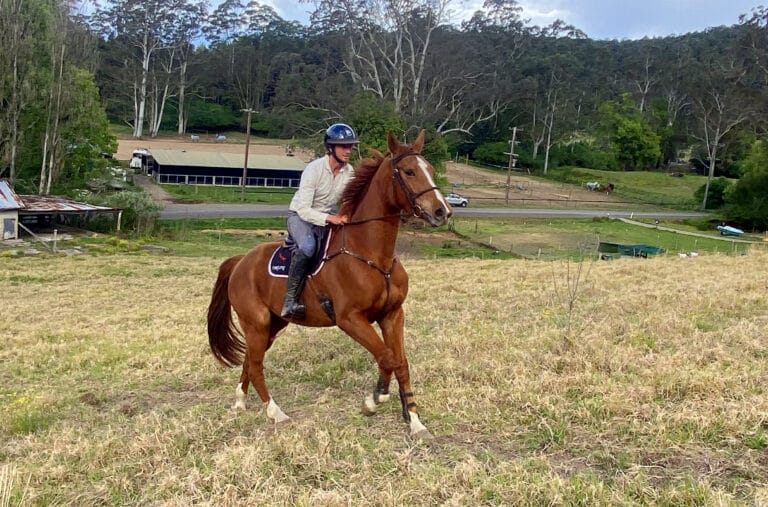In Part Two of CHARLIE BRISTER’s two part fitness series, he hits top gear with some expert tips on getting your equine athlete ready for the rigours of eventing. ~ Read Part 1: Good To Go ‘Show Jumping’ here.
Last issue we talked about several areas that are important to consider when getting your horse fit: cardiovascular fitness, strength and conditioning. Following on from that, the rider has several things to consider, including the ride-ability of the horse, diet, and obstacle height.
Now let’s look at taking your horse’s fitness up a step. The days of long format eventing are gone. Back in the day, combinations covered roughly 27 kilometres of roads, tracks, steeplechase, and cross country. This was very demanding and for several reasons has been phased out. But we can still learn a lot from the old school approach to getting horses fit for those competitions. At the higher levels of competition you still need a very fit horse regardless of discipline, and this framework will hopefully enable your horse to be fit for anything. The more balanced your fitness program, the more easily adjustable it’ll be to meet your requirements with a happy, fit horse.
While a low level dressage rider might not think they need to consider this, it’s definitely worth thinking about. Doing extra fitness work is an easy way to put variety into your horse’s training and even prevent injuries.
Now, some of you might be thinking ‘oh, my horse is super hot, I don’t need to do any fitness work’. This work isn’t necessarily about making your horse go faster or get hotter, although that can happen. It’s about providing their body with a solid foundation to handle the workload you put on them.
Long and slow
At the beginning of a horse’s fitness program the intensity will be a lot lower. Walking shouldn’t be underestimated. Especially before training you should walk for at least ten minutes. This can be repeated at the end of the ride for the cool down. When looking to increase your horse’s fitness, start adding longer walks in before anything else. Even going on a steady trail ride is beneficial. This will benefit their body without too much impact. It is also good for their brain. Getting out of the arena will help prevent boredom. How good is finding a fallen tree to jump on the trail? That can be an easy way to add more variety.
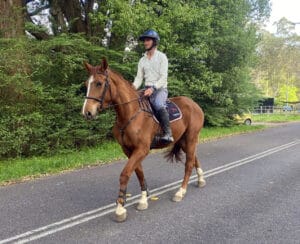
Now for trot sets
While not as essential for dressage, the next step in building fitness for eventers and show jumpers are trot sets around the paddock. While doing this they don’t have to be in a perfect dressage frame. You still want them balanced and listening to the aids though.
While doing trot work you will find the two point position very beneficial. Two point trot makes it a little harder to balance than doing rising trot. This will activate your core so both you and your horse are benefiting.
Short and fast
Once you’ve done plenty of long and slow work you can add in the fun stuff. Sprints over a shorter distance can boost your horse’s fitness and also test whether you have the control you need for competitions. When going faster it’s vital the footing is suitable. Walking along the road is fine but cantering on a hard surface is detrimental to your horse’s joints.
Quite often there are privately owned racehorse farms that will rent their track out to riders wanting to do canter work. This makes things a lot easier because they usually know the distance around the track, and this will help you keep track of how far you’re going.
If you have no access to suitable footing do more work at a slower pace. This is where hills are very useful. Speed is not as important, as the gradient will really benefit the horse’s muscles. Also, remember that in the wild, horses will cover at least 15 kilometres a day. Much of that is at the walk. Today’s domesticated horse is unlikely to get close to that. So if you’re struggling with doing fast canter work, or finding a worthwhile hill, go back to the walk. It isn’t as fun but it’s just as good for your horse.
Monitoring your horses fitness
A lot of your horse’s progress will be assessed by feel and the feedback you get during and after each ride. It’s hard to beat simply paying close attention to how your horse is feeling. But to really fine tune their fitness you can get the help of some useful technology. Heart rate monitors and phone apps such as Equilab provide a lot of valuable information. A heart rate monitor will tell you if your horse is actually working hard enough and how quickly they recover. And rather than a guestimate, Equilab will analyse how fast you’re going and how long you’re spending in each pace.
Thermometers are very handy for eventing and endurance. Due to the increased demands of these sports, ensuring the horse’s temperature returns to normal as soon as possible is very important. This is something you want to practice before the competition. Regardless, it’s part of good horse management to be able to easily take their temperature if something looks off. For example, if your horse has diarrhoea and a temperature call the vet asap.
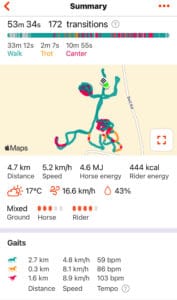
Jump off
We haven’t spoken too much about jumping yet, because the aim is to provide a solid base of fitness and conditioning before overly stressing your horse’s legs by jumping too much. Once they are stronger in their body, grid-work becomes an invaluable tool in increasing their power by developing their footwork and encouraging them to push off from the hind end without using speed.
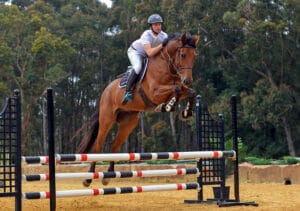
A commonly used but effective grid can easily be set up on your arena. Start with two placing poles 1.2 metres apart, followed by 2.7 metres to a cross rail, 3 metres to a vertical, 5.5 metres to an oxer, and 6.5 metres to the final oxer (see diagram).
Begin with all the jumps as poles on the ground. This will help your horse gain confidence. Start by trotting in and gradually increase the height of the jumps depending on your horse’s ability. If you run into trouble, always lower the jump in preference to reprimanding the horse.
Once your horse understands this exercise, practice it at different points in your ride. How do they handle the grid early in the ride? Gallop around the arena for five laps then trot in again – how well does your horse come back to you, or are they still thinking gallop?
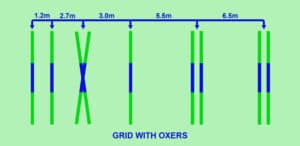
A helping hand
Not surprisingly, there are experienced riders out there who have been in similar situations to you. Don’t be afraid to reach out and ask about fitness plans, or what to consider when getting your horse fit, but be sure to ask someone you respect and who understands your situation. Know what your goal is and work back from there. Use a system. Be progressive and gradually increase the workload.

